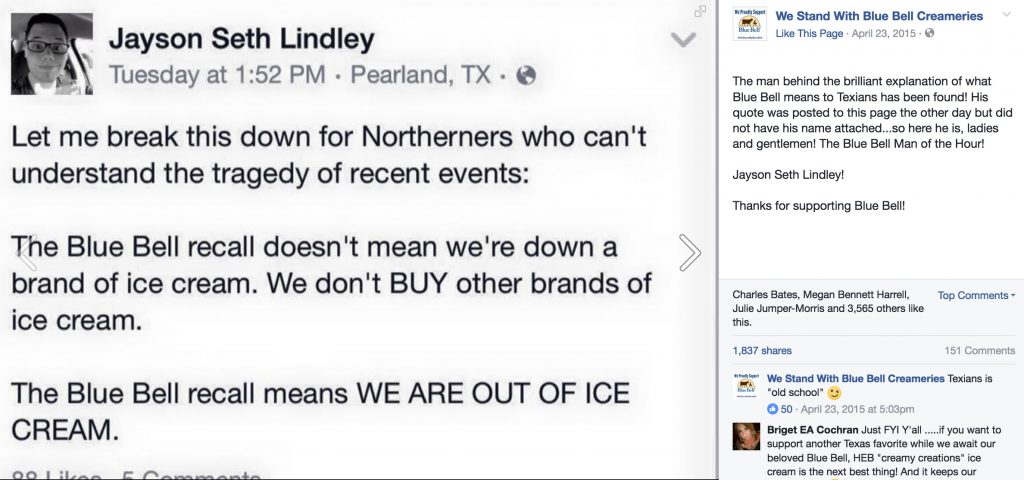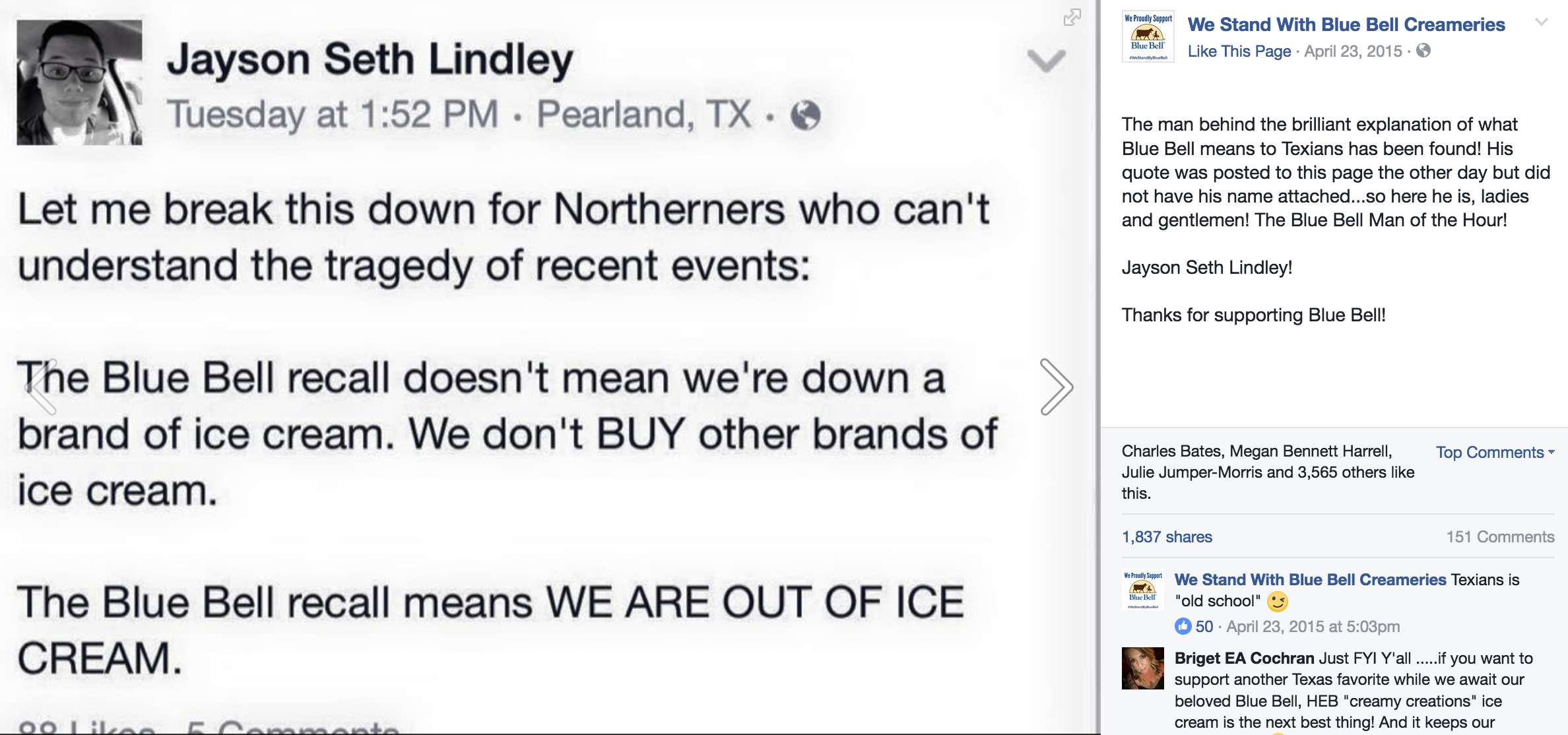When it comes to customer loyalty and crisis response, communication is key.
And a little planning can go a long way toward repairing the damage.
Blue Bell is a great example of how a company can bounce back from a potentially reputation-damaging event.
For ice cream connoisseurs living in Texas, Oklahoma, Colorado, and a few surrounding states, Blue Bell isn’t just a brand of ice cream – it’s THE brand of ice cream.
Known for its nostalgic packaging and down-home personality as much as for iconic flavors like Cookies ‘n Cream, Dutch Chocolate, and its original Homemade Vanilla – Blue Bell is a beloved Texas institution with a die-hard fan base.
But in the spring of 2015, “The Little Creamery in Brenham” – which is actually a $600 million-dollar corporation with manufacturing plants and operations in several states – was linked to a Listeria outbreak that originated in the company’s Broken Arrow, Oklahoma, factory.
Three people died, and at least ten people were hospitalized.
For the first time in its history, Blue Bell recalled its products from store shelves.
A temporary shutdown – another first for the company – followed, as Blue Bell brought in outside specialists to clean and sanitize every piece of equipment used in the manufacturing process.
As the cleanup efforts got underway in the company’s plants, a different kind of cleanup began in Blue Bell’s Brenham, Texas, headquarters.
Blue Bell executives hired a public relations and crisis communication expert to help them craft a response and manage their interactions with customers and the community.
Hesitation isn’t an option
In the event of a crisis – whether it’s a Listeria outbreak, a defective product, or even a data breach involving sensitive customer data – you can’t afford to hesitate.
At best, your silence and inaction is interpreted as evasiveness; at worst, you’re opening the door to rumors, speculation, and accusations.
Blue Bell hired Gene Grabowski, a self-described “Crisis Guru” and public relations expert, to help them re-establish consumers’ and retail partners’ trust in Blue Bell ice cream.
Grabowski has seen this dynamic firsthand, and he has worked on crisis management campaigns for companies ranging from toy manufacturers to pet food companies to national restaurant chains.
The company’s efforts paid off.
With Grabowski’s guidance, Blue Bell survived the recall with its reputation largely intact.
Rather than pointing fingers or voicing criticisms, loyal customers rallied around Blue Bell and took to social media to voice their support, creating fan pages like “We Stand With Blue Bell Creameries.”

When the company released a limited selection of products post-recall, fans took triumphant midnight selfies in front of newly stocked shelves.
The lesson? When people really love a product or company, they’re willing to forgive and forget. Tweet this
Of course, not every company in crisis has the advantage of a big-name PR guru.
We interviewed Gene Grabowski to learn more about responding to a crisis with your reputation and your customer base intact.
Build your team
Grabowski says that effective crisis communication does not start with a plan.
He’s quick to point out that plans are important, but a good strategy should begin with people.
It’s critical to have a team already positioned when there’s a crisis--one that’s been carefully assembled beforehand, because it’s impossible to do that in the midst of the chaos.
There are too many variables in a crisis that can never be planned for – like looking up and seeing CBS on the doorstep.
Your plan can predict what 100 questions could be, but remember, there could be that 101st question that you weren’t expecting .
It takes creativity and experience to know how to answer that one as well.
-Gene Grabowski
For some companies, it might make sense to look in-house and build a team of creative, smart people who can remain cool under pressure.
Other companies – like Blue Bell, for example – may prefer to seek outside help from a consultant or company that specializes in crisis communication.
Either way, Grabowski’s advice remains the same: Build your team first.
From there, if you want to sketch out a rudimentary crisis response plan, that’s fine.
But remember that a plan can only take you so far, especially in a crisis where, literally, anything can happen.
Assess (and plan for) risk
Once you have a crisis team in place, it’s time to think about worst-case scenarios.
Grabowski recommends creating a matrix of high-risk, highly problematic scenarios.
The list will vary depending on the type of company, product, and customers involved.
For retailers and financial institutions, for example, data breaches and hacking might be at the top of the list.
For food companies, Grabowski says, “It’s likely that sooner or later, contamination will become an issue.”
Once you have a list of potential crisis situations, think about how you’ll respond.
While every situation and company is different, a basic plan should cover a few broad areas like:
- How are you going to notify your customers of the crisis? How will you ensure that people hear facts, not rumors or theories? Will you issue press releases? Sit for interviews? Who will be the point person for media inquiries?
Grabowski says it’s important to send the message that the company understands the problem and is completely focused on finding a solution.
He added that this is how Blue Bell managed to maintain its relationships with its customers and retailers during the time of the crisis. “We spent a great deal of time communicating directly with them about how we were resolving the problem, so that they would trust us enough to keep the product on their shelves when the recall was over,” he said.
Blue Bell made a point of communicating with customers early and often, issuing press releases every time they expanded a recall or learned more about the source of the outbreak.
- Recalls and regulations. This is where an experienced team is critical, says Grabowski. Whether you’re working with in-house executives or an outside consulting team, you’ll want to make sure that you have people on your team who know the rules, inside and out. These are the folks who will help make key decisions — such as Blue Bell’s decision to issue a voluntary recall of their products, rather than waiting for a directive from the FDA.
- Admit your mistake. And then apologize. Don’t underestimate the power of a sincere apology. Rather than sidestepping the issue, admit that you made a mistake – and let your customers know that you’re working to make things right. The company’s CEO and President Paul Kruse released a video apology, saying that the incident had left him “heartbroken.”
- Media (and social media) coverage. “The rumor mill has to be nipped in the bud as soon as possible,” Grabowski said. “You have to react to rumors in real time. Correct everything that’s incorrect and set the record straight immediately.”
The best way to approach a media outlet that has published erroneous information is to be direct. “Contact them and say, ‘I know you want to be accurate, so please set the record straight.’ You can’t let rumors grow; they’re like weeds in a garden.”
It’s equally important to pay attention to social media.
Blue Bell made a point of communicating with its customers through social sites like Facebook.
And, not every company has been around as long as Blue Bell (the company is more than 100 years old).
Advantages aside, though, there are a few important lessons that business owners in every industry can take away from the Blue Bell crisis – and its well-crafted response.
We interviewed Gene Grabowski to learn more about responding to a crisis with your reputation and your customer base intact.
Build your team
Grabowski says that effective crisis communication does not start with a plan.
He’s quick to point out that plans are important, but a good strategy should begin with people.
“It’s critical to have a team already positioned when there’s a crisis–one that’s been carefully assembled beforehand, because it’s impossible to do that in the midst of the chaos,” Grabowski said. “There are too many variables in a crisis that can never be planned for – like looking up and seeing CBS on the doorstep. Your plan can predict what 100 questions could be, but remember, there could be that 101st question that you weren’t expecting. It takes creativity and experience to know how to answer that one as well.”
For some companies, it might make sense to look in-house and build a team of creative, smart people who can remain cool under pressure.
Other companies – like Blue Bell, for example – may prefer to seek outside help from a consultant or company that specializes in crisis communication.
Either way, Grabowski’s advice remains the same: Build your team first.
From there, if you want to sketch out a rudimentary crisis response plan, that’s fine.
But remember that a plan can only take you so far, especially in a crisis where, literally, anything can happen.
Assess (and plan for) risk
Once you have a crisis team in place, it’s time to think about worst-case scenarios.
Grabowski recommends creating a matrix of high-risk, highly problematic scenarios.
The list will vary depending on the type of company, product, and customers involved.
For retailers and financial institutions, for example, data breaches and hacking might be at the top of the list.
For food companies, Grabowski says, “It’s likely that sooner or later, contamination will become an issue.”
Once you have a list of potential crisis situations, think about how you’ll respond.
While every situation and company is different, a basic plan should cover a few broad areas like:
- How are you going to notify your customers of the crisis? How will you ensure that people hear facts, not rumors or theories? Will you issue press releases? Sit for interviews? Who will be the point person for media inquiries?
Grabowski says it’s important to send the message that the company understands the problem and is completely focused on finding a solution.
He added that this is how Blue Bell managed to maintain its relationships with its customers and retailers during the time of the crisis. “We spent a great deal of time communicating directly with them about how we were resolving the problem, so that they would trust us enough to keep the product on their shelves when the recall was over,” he said.
Blue Bell made a point of communicating with customers early and often, issuing press releases every time they expanded a recall or learned more about the source of the outbreak.
- Recalls and regulations. This is where an experienced team is critical, says Grabowski. Whether you’re working with in-house executives or an outside consulting team, you’ll want to make sure that you have people on your team who know the rules, inside and out. These are the folks who will help make key decisions — such as Blue Bell’s decision to issue a voluntary recall of their products, rather than waiting for a directive from the FDA.
- Admit your mistake. And then apologize. Don’t underestimate the power of a sincere apology. Rather than sidestepping the issue, admit that you made a mistake – and let your customers know that you’re working to make things right. The company’s CEO and President Paul Kruse released a video apology, saying that the incident had left him “heartbroken.”
- Media (and social media) coverage. “The rumor mill has to be nipped in the bud as soon as possible,” Grabowski said. “You have to react to rumors in real time. Correct everything that’s incorrect and set the record straight immediately.”
The best way to approach a media outlet that has published erroneous information is to be direct. “Contact them and say, ‘I know you want to be accurate, so please set the record straight.’ You can’t let rumors grow; they’re like weeds in a garden.”
It’s equally important to pay attention to social media.
Blue Bell made a point of communicating with its customers through social sites like Facebook.

- Think prevention. All companies have issues to manage — but Grabowski said that when a problem becomes a full-blown crisis, it’s often because the company didn’t deal with it before it got out of hand. Does your organization have any current problems that have the potential to spiral out of control? Make sure you don’t ignore present issues while planning for the future.
Crisis recovery—Blue Bell and beyond
Grabowski is the first to admit that Blue Bell has bounced back remarkably well from its listeria crisis. “Their case is very different from most other companies,” he said. “They had the benefit of over 100 years of brand loyalty . . . and they had successfully cultivated a family-owned, family-run image with good old-fashioned family values. That’s how they’ve survived this.”
Of course, that’s not to say startups or companies with a more corporate or edgy image can’t survive a crisis.
As Grabowski is quick to point out, accidents happen to everyone – and the key to surviving is preparation, plain and simple: “You get through this by keeping an open mind for solutions, by having the best people on your team, and by demonstrating that you’re ready to do whatever is necessary to prove the product is safe to be on the shelves again.”










